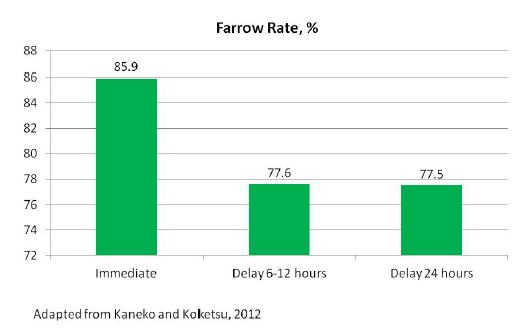



Gilt Reproductive Management Improves Sow Lifetime Productivity
Based on the results of a recent survey, Ronald O. Bates (State Swine Specialist at Michigan State University, MSU) offers advice on gilt management in the latest issue of 'MSU Pork Quarterly'.Introduction
Improving sow productivity is an on-going challenge across the pork industry. Improving pigs per sow per year
is not only about improving litter size but also improving female retention.
It has been recognised that an effective
gilt development and reproductive management program can improve sow herd retention rate which
in turn should improve such characteristics as pigs per sow per year. This is due to the sow herd maintaining
a high proportion of parity 2 and greater sows. However, there is poor agreement as to what gilt management
practices are necessary to improve sow herd retention.
There was a recent research study (Kaneko and Kofetsu,
2012) that evaluated sow productivity in 96 herds and related gilt management practices to sow performance.
Results
This study worked with the sow productivity records from 96 farms and evaluated 15,574 gilt records. Each
farm completed surveys that detailed their gilt management programme.
Farms were categorised into three sow
productivity categories, based on pigs per sow per year. Farms classified as 'High' achieved more than 23.8 pigs
per sow per year. 'Intermediate' sow productivity farms fell within the range of 20.8 to 23.8 pigs per sow per
year. Farms that were categorised as 'Low sow productivity' farms produced 20.7 or less pigs per sow per year.
This study reported that age at mating was lower among High and Intermediate sow productivity farms compared
to Low sow productivity farms (Table 1). Gilts from high sow productivity farms also had higher farrow
rates than gilts from farms in the other two categories. This was true for gilts that settled on their first service
as well as those that recycled and subsequently settled on a later service.
Table 1. Gilt reproductive characteristics for herds differing in pigs per sow per yeara

a Adapted from Kaneko and Koketsu, 2012. b,c Means within a row with different superscripts differ (P<0.05).
In describing the gilt management programmes for these farm categories, High and Intermediate sow productivity
farms began boar contact with gilts at approximately 203 days of age while Low productivity sow farms began
boar contact with gilts at approximately 213 days of age. Therefore, it appears all farms were trying to mate
gilts at their second oestrus but High productivity sow farms began boar contact with gilts sooner.
A greater
proportion (32 per cent) of high sow productivity sow farms used gilt development diets than Intermediate
(8.5 per cent) and Low (0 per cent) sow productivity sow farms. Also age at farrowing was 13.7 days younger for gilts on
farms that used direct boar contact to stimulate oestrus versus farms that used indirect boar contact. This is
in agreement with recent research from Michigan State University that reported that gilts that farrow at or
before a year of age had improved sow longevity compared to females that farrowed after a year of age (Hoge and Bates, 2011).
Farms also listed the time gilts were mated after detected in heat. Farms that mated gilts immediately after
detected heat had higher gilt farrowing rates than farms that waited either six to 12 hours or 24 hours to mate or
inseminate gilts (Figure 1). This may be because ovulation occurs sooner within the oestrous period of gilts than
sows. Therefore, mating immediately after gilts are detected in heat may allow for sperm to go through capacitation
and be ready to fertilise eggs at ovulation.
Figure 1. Farrow rate of gilts mated at different times after first detected oestrus

Summary
The gilt development practices that significantly improved subsequent sow productivity in this study are not the only management practices that may improve subsequent reproductive capacity. Certainly, other gilt development practices have been suggested that could improve subsequent sow performance. However, this study identifies robust management practices that should be seriously considered for inclusion in gilt development programs. Specifically, this study suggests the following be considered for gilt development programmes:
- Gilt development rations should be considered
- Oestrus detection should begin at approximately 6.5 months of age and gilts mated at their second or later oestrus
- Oestrus detection should allow for direct boar contact
- For the heat in which gilts will be mated, mating should occur soon after detected in heat and while in standing heat
- Gilts that have been serviced should be limit fed until pregnancy is confirmed and then fed to condition
- Gilts should farrow at approximately 11 to 12 months of age.
Gilt development is an important aspect of sow farm productivity and attention to detail and consistent applications
of fundamental gilt management practices should improve subsequent productivity and longevity.
October 2012








